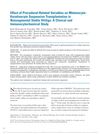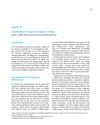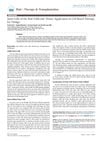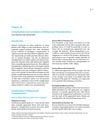Search
forLearn
4 / 4 resultslearn Low Level Laser Therapy
laser therapy for anti-inflammatory and likely insignificant hair regrowth effects
learn Osteopontin
signaling protein that, when suppressed, may grow hair by reducing inflammation and stem cell loss
learn Thymosin Beta 4
Research
5 / 1000+ resultsresearch Repigmentation of Leukotrichia Due to Retrograde Migration of Melanocytes After Noncultured Epidermal Suspension Transplantation
The treatment improved hair color in most vitiligo patients without major side effects.

research Effect of Procedural-Related Variables on Melanocyte–Keratinocyte Suspension Transplantation in Nonsegmental Stable Vitiligo: A Clinical and Immunocytochemical Study
Different techniques for vitiligo treatment work similarly well, with some better for specific body areas.

research Classification of Surgical Therapies in Vitiligo
Surgical therapies for vitiligo vary in effectiveness, with combination therapy and medical tattooing recommended for better results.

research Stem Cells of the Hair Follicular Tissue: Application in Cell-Based Therapy for Vitiligo
Hair follicle stem cells could be used to treat the skin condition vitiligo.

research Complications and Limitations of Melanocyte Transplantation
Melanocyte transplantation can safely restore skin color, especially in stable vitiligo, but must be chosen carefully based on the disease phase.
Community Join
5 / 81 resultscommunity 5 alpha reductase type 1 is in brain tissue producing the main endogenous gabaergic allopregnanolone, not 2. How can finasteride as a 5ar2 lower that?
Finasteride and dutasteride are discussed for hair loss, with concerns about their effects on neurosteroids and potential side effects like depression. Alternatives like topical estrogen and lifestyle changes are considered, with varying opinions on mental health and hair regrowth.
community Why nobody uses 0.25% (2.5mg/ml)?
The conversation is about the effectiveness of 0.25% topical finasteride compared to other concentrations and forms. Users discuss its potential for better scalp DHT reduction and fewer side effects, with some preferring topical over oral treatments.
community The truth about Dutasteride (w/ sources)
The effectiveness of Dutasteride compared to Finasteride in treating hair loss, with evidence given such as studies and experiences, as well as discussion around whether one should switch from Finasteride to Dutasteride. There is also a discussion on post-Dutasteride syndrome.
community Clearing the air on how non-surgical treatments really work
Treatments for hair loss, including finasteride, dutasteride, minoxidil, ketoconazole, microneedling, and low level laser light therapy, which aim to reduce DHT production, increase cell absorption and blood flow, and stimulate epidermal stem cells. It also stresses the importance of patience when using these treatments.
community Is tazarotene potentially better than tretinoin in combination with topical minoxidil?
Tazarotene may be more effective than tretinoin when combined with topical minoxidil for hair loss due to its selective binding to RAR-beta and gamma, though it can cause irritation. Tazarotene's potency can lead to indirect inflammatory reactions despite potentially causing less irritation than tretinoin.